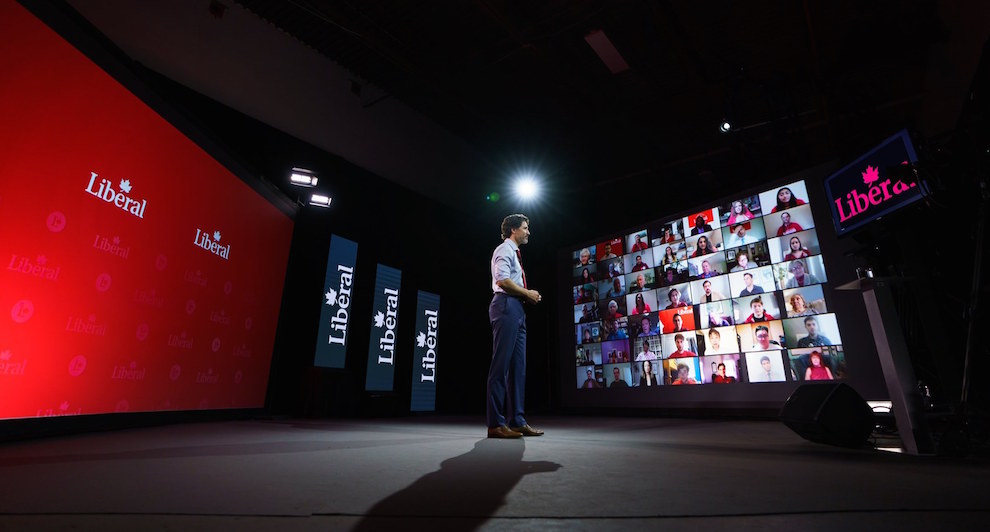Following the train wreck of the Conservative party’s virtual policy convention, both the Liberals and NDP held conventions on the same weekend.
Since it is hard enough for any party to get public attention for a conclave of policy wonks, competing for the same time slot might seem strange scheduling. It was actually appropriate, since both parties are fishing for votes in the same pond. Neither is interested in the pond roiled up by the Tories.
The Trudeau Liberals saw their convention as an opportunity to further brand their public offering in the next election as a left-centre government with a progressive agenda for the post-pandemic recovery.
NDPers prop up the Liberal minority, and are reduced to either trying to take credit for progressive Liberal acts, or taking blame for keeping a party in power that they describe as phony progressives: an infuriating bind.
But on the evidence of competing policy fests, the public will find it difficult to distinguish between the two, leaving the Liberals as the people in place who can actually deliver.
Liberal resolutions came entirely from the reform direction. Topping the list is national pharmacare for all; followed by a universal basic income; enforceable national standards for long-term care; and a high-speed national rail system.
Three prioritized resolutions call for a Green New Deal; a green economic recovery; and a “No worker left behind” plan in the transition to a low-carbon economy. Other resolutions call for action on systemic racism and gender-based violence.
Interestingly, one resolution was rejected which would have called on the government to impose an inheritance tax on all assets over $2 million and reduce the capital gains tax exemption by 40 per cent, thus drawing a line between the Liberals and the NDP, who called for targeting billionaires. That said, missing from the agenda were any resolutions reflecting positive conservative ideas from the once-ascendant business wing of the party.
Absent the Turners and Martins who dominated economic policy in previous Liberal governments, the star turn of Mark Carney, former governor of the Banks of both Canada and England, served to show just how far off-centre the Liberals have now moved. Instead of the austerity and inflation-fighting mania of earlier bank governors, Carney urges a capitalism more concerned about reducing inequality and achieving a greener economy.
It is easy to be cynical about Liberal promises. No doubt a number of these aspirations will never see the light of day, and others may be severely compromised when enacted.
But the NDP are mistaken to claim unbroken continuity from a past when the Liberals campaigned from the left and governed from the right.
The old “Government Party” — the classic big-tent, middle-of-the road brokerage party that could shift as easily to the right as to the left in response to changing wind direction — is dead and buried.
Seismic shifts in society, economy and in political marketing and communication have rendered brokerage politics all but obsolete.
Big data, micro-targeting and social media have sharpened the boundaries between groups of voters and are polarizing electorates along increasingly tribal lines which are pulling away from each other.
Tribalization is not as advanced in Canada as it is in the U.S., but it has pulled the Conservative party much further to the right, consolidating their base of about a third of Canadians, concentrated in Alberta and Saskatchewan, with their petro-state economies and ideology to match.
The other two-thirds are split between Liberal, NDP, Green and Bloc Québécois supporters who have a great deal in common in political values and policy preferences (broadly on the moderate centre-left) but are divided regionally on partisan lines — which leaves open the possibility of the right-wing minority imposing itself on the country over a fragmented majority.
Practically, Liberals have no hope of breaking into the solid Tory base, but must consolidate the centre-left to avert a Tory win.
Other factors push Liberals leftward. The double whammy of the 2008 financial crash and the pandemic have done serious damage to the neoliberalism that once reigned over economic policy, leaving the Liberals to pursue big-state initiatives.
With interest rates at historic lows, deficit spending poses no great challenge.
Finally, the Biden administration is pursuing massive New Deal-type recovery projects and raising corporate taxes, leaving even greater room for financing Canadian recovery without impeding international competitiveness.
The Liberals will campaign from the left. This time there is better reason to think that they will govern from the left as well.
Reg Whitaker is distinguished research professor emeritus, York University, and adjunct professor of political science, University of Victoria. Among his nine published books he is author of The Government Party: Organizing and financing the Liberal Party of Canada, 1930-58.
Image credit: Justin Trudeau/Facebook




